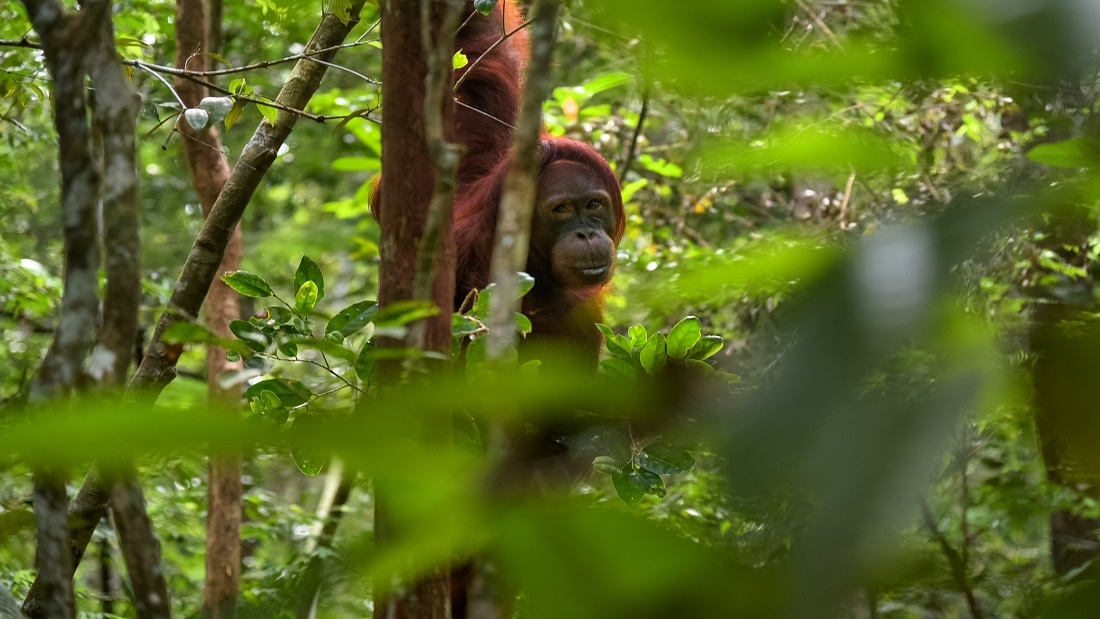Palm Oil

Palm oil is very big business – it is found in many items on supermarket shelves; from margarine to lipstick. Most oil palms grow in areas that were once tropical forests in Malaysia and Indonesia. ‘Slash and burn’ deforestation is used to clear the way for oil palm plantations, with negative impacts seen on a regional and global scale. The expansion of palm oil production has led to a huge loss of wildlife, with substantial numbers of elephants, rhinos, tigers and orangutans losing their homes. Some organisations are trying to embrace sustainable palm oil production. You have the power to decrease demand for palm oil by voting with your wallet.
What is palm oil?
Palm oil is extracted from the fruit pulp of oil palm trees. It is a $62 billion industry and the oil is found in roughly half of all items on supermarket shelves.7UNEP. 2016. Conservationists and palm oil industry should collaborate to protect great apes, fragile ecosystems. www.un.org/apps/news/story.asp?NewsID=55520#.WXiya4jyu70 But did you know that household items containing palm oil, such as shampoo and shaving gel, are contributing to climate change and biodiversity loss?
Palm oil is the world’s highest yielding and least expensive vegetable oil, making it a popular choice for millions of companies globally, and a source of biofuel. Of the total world production, 5% is used for biofuels, 24% for cosmetics and 71% by the food industry.8Gesteiro E, Guijarro L, Sánchez-Muniz FJ et al. 2019. Palm Oil on the Edge. Nutrients. 11, 9. It is the most widely consumed vegetable oil worldwide and half of all packaged products contain palm oil.9WWF. 2018. Palm oil. https://www.wwf.org.au/what-we-do/food/palm-oil From ice cream and instant noodles, to shampoo and lipstick, the demand for cheap palm oil is steadily rising.
Between 1980 and 2014, global palm oil production increased 15-fold; from 4.5 million tonnes to 70 million tonnes. Industrial-scale plantations occupy an area of 18.7 million hectares worldwide, with smallholder oil palm plantations also occupying a significant area. Palm oil demand is expected to grow by 1.7% per year between now and 2050.10IUCN. 2018. Oil palm and biodiversity. A situation analysis by the IUCN Oil Palm Task Force. IUCN Oil Palm Task Force Gland, Switzerland: IUCN. https://www.iucn.org/resources/issues-briefs/palm-oil-and-biodiversity
Because the oil palm’s range is limited to the humid tropics, expansion has come at the expense of species-rich and carbon-rich tropical forests.11Vijay V, Pimm SL, Jenkins CN et al. 2016. The Impacts of Oil Palm on Recent Deforestation and Biodiversity Loss. PLoS One. 11 (7) e0159668. Because most oil palms are grown in areas that were once tropical forests, expansion now represents one of the most pervasive threats to biodiversity, driving the destruction of many tropical natural ecosystems.12Lees AC, Moura NG, de Almeida AS et al. 2015. Poor prospects for avian biodiversity in Amazonian oil palm. PLoS One. 10 (5) e0122432.
Palm oil terminology
Common alternative ingredient listings for palm oil include: vegetable oil, vegetable fat, palm kernel, palm kernel oil, palm fruit oil, palmate, palmitate, palmolein, glyceryl, stearate, stearic acid, elaeis guineensis, palmitic acid, palm stearine, palmitoyl oxostearamide, palmitoyl tetrapeptide-3, sodium laureth sulfate, sodium lauryl sulfate, sodium kernelate, sodium palm kernelate, sodium lauryl lactylate/sulfate, hyrated palm glycerides, etyl palmitate, octyl palmitate, palmityl alcohol.14Kadandale S, Marten R and Smith R. 2019. The palm oil industry and noncommunicable diseases. Bulletin of the World Health Organisation. 97 (2) 118-128.
The island of Borneo is the third-largest island in the world and the largest in Asia. It is politically divided among three countries: Malaysia and Brunei in the north and Indonesia to the south. Plantation industries have been the principle driver of deforestation in Malaysian Borneo over the last four decades – their role in deforestation in Indonesian Borneo has been less marked. However, rapid conversion of forests in Indonesian Borneo to industrial plantations has increased steeply since 2005.16Gaveau DL, Sheil D, Husnayaen et al. 2016. Rapid conversions and avoided deforestation: examining four decades of industrial plantation expansion in Borneo. Scientific Reports. 6, 32017.
The vast majority, around 90%, of the world’s oil palms are grown in Malaysia and Indonesia – islands containing some of the greatest biodiversity on Earth – where there is a direct relationship between the growth of oil palm plantations and deforestation. As the global demand for palm oil increases rapidly, global production increases rapidly in response.
Plantations are now spreading across Asia, Africa and Latin America, which is threatening the habitats of endangered species like orangutans, elephants and tigers. Intensive production of palm oil is also contributing to environmental problems such as air, soil and water pollution, as well as soil erosion.3WWF. 2018. Palm oil. https://www.wwf.org.au/what-we-do/food/palm-oil
Forest fires release sequestered carbon (stored in the exisiting vegetation) into the atmosphere, thus contributing to global warming. Forest and peatland burning is a significant source of greenhouse gas emissions and tropical Asia is considered a major source of this type of activity. In this region, several studies have reported significant biomass burning emissions from deforestation, slash and burn agriculture, agricultural residue burning and peatland burning; which is a major source of carbon release. In short, oil palm expansion threatens biodiversity and increases greenhouse gas emissions.5Vijay V, Pimm SL, Jenkins CN et al. 2016. The Impacts of Oil Palm on Recent Deforestation and Biodiversity Loss. PLoS One. 11 (7) e0159668.
On a global scale, palm oil makes a sizeable contribution to climate change from the draining and conversion of tropical peat forests, and forest fires. The destruction of tropical peat forests in Indonesia is particularly damaging because these forests store more carbon per hectare than any other ecosystem in the world. Indonesia’s high deforestation rate has made it the third-largest global emitter of greenhouse gases.3WWF. 2018. Palm oil. https://www.wwf.org.au/what-we-do/food/palm-oil
The Southeast Asian Haze
Fires set in forests and on carbon-rich peatland to quickly clear the land for palm oil plantations can lead to significant air pollution impacts which can be seen at a regional and even a global level. In Asia, fires from peatlands and deforestation are most common in Indonesia. The resulting smoke plumes can travel long distances causing trans-boundary air pollution across the region.1Hayasaka H, Noguchi I, Putra EI et al. 2014. Peat-fire-related air pollution in Central Kalimantan, Indonesia. Environmental Pollution. 195, 257-266.
The 2015 Southeast Asian haze was an air pollution crisis caused by fires that affected several countries including Brunei, Indonesia (especially Sumatra and Borneo), Malaysia, Singapore, southern Thailand, Vietnam, Cambodia and the Philippines. The fires were blamed for up to half a million cases of respiratory infections and endangered animals were forced to flee the forests. Six Indonesian provinces declared a state of emergency, schools in neighbouring Singapore and Malaysia were closed and flights grounded. One study estimates that it caused over 100,000 deaths across Indonesia, Malaysia and Singapore.2Koplitz SN, Mickley LJ, Marlier ME et al. 2016. Public health impacts of the severe haze in Equatorial Asia in September-October 2015: Demonstration of a new framework for informing fire management strategies to reduce downwind smoke exposure. Environmental Research Letters. 11, 9.
The negative impacts of oil palm development on biodiversity, and on orangutans in particular, have been well documented.3Wich SA, Garcia-Ulloa J, Kühl HS, Humle T, Lee JS and Koh LP. 2014. Will oil palm’s homecoming spell doom for Africa’s great apes? Current Biology. 24 (14) 1659-1663. Orangutans are great apes, currently only found only in the rainforests of Borneo and Sumatra, they are listed as critically endangered on the IUCN Red List of Threatened Species.4IUCN. 2020. The IUCN red list of threatened species. https://www.iucnredlist.org/
They used to be considered as one species but in 1996 they were reclassified as two species: Bornean orangutans and Sumatran orangutans. In 2017, a newly described Tapanuli orangutan was discovered in the Batang Toru forests in Sumatra, with a severely fragmented population of less than 800 individuals.5IUCN. 2017. New orangutan species described in Indonesia. https://www.iucn.org/news/species/201711/new-orangutan-species-described-indonesia The expansion of plantations has caused substantial losses of their natural habitat and so all three species are currently listed as critically endangered. We should be able to brush our teeth or eat a snack without pushing orangutans into extinction.

Roundtable on Sustainable Palm Oil
The main organisation responsible for the certification of sustainable palm oil is the Roundtable on Sustainable Palm Oil (RSPO). It is composed of oil palm producers, processors or traders, consumer goods manufacturers, retailers, investors, and environmental and social non-governmental organisations (NGOs), to develop and implement global standards for sustainable palm oil. With more than 4,000 members worldwide who represent many different links along the palm oil supply chain, the RSPO has a list of criteria which companies must comply with in order to gain certification.1RSPO. 2020. Roundtable on Sustainable Palm Oil. About. www.rspo.org/about
Set up in 2004, the RSPO aims to reassure shoppers and businesses that products bearing its label are not connected to rainforest destruction, (including the habitats of endangered species such as orangutans), human rights abuses or contributing to the climate crisis.
The RSPO has been criticised by a number of environmental groups; issues include the impact of palm oil plantations on biodiversity and orangutans, destruction of tropical forest and the burning and draining of large areas of peat swamp forests. In 2015, a report from the Environmental Investigation Agency (EIA) – a not-for-profit UK organisation – called Who Watches the Watchmen? was highly critical of the RSPO, revealing a catalogue of failures within their certification system and accusing it of effectively giving false environmental credibility to products carrying its guarantee, a practice known as ‘greenwashing’.2EIA. 2020. Sustainable palm oil watchdog’s credibility questioned by independent review. https://eia-international.org/news/sustainable-palm-oil-watchdogs-credibility-questioned-by-independent-review/
The EIA’s report said: “Auditing firms are fundamentally failing to identify and mitigate unsustainable practices by oil palm firms. Not only are they conducting woefully substandard assessments but the evidence indicates that in some cases they are colluding with plantation companies to disguise violations of the RSPO Standard. The systems put in place to monitor these auditors have utterly failed.”3EIA. 2015. Who Watches the Watchmen? Auditors and the breakdown of oversight in the RSPO. https://eia-international.org/wp-content/uploads/EIA-Who-Watches-the-Watchmen-FINAL.pdf
The RSPO expelled two of the companies accused of malpractice in the EIA report and said they believed that the nine case studies presented by EIA, however serious, should not lead to a general dismissal of the certification system. In 2016 they introduced an auditor registry in partnership with a third-party body to ensure better oversight of RSPO auditors. In 2018, they adopted new principles and criteria to ensure no deforestation, no new planting on peat, the protection of human rights defenders, improved workers’ rights and better smallholder inclusion. But in 2019, EIA published a follow-up report, Who Watches the Watchmen 2, highlighting the watchdog’s failings to address the concerns raised in their first report. The EIA said that the RSPO’s Assurance Task Force, set up to tackle the issues, was one of the worst-run and poorest performing parts of the organisation and had failed to complete its objectives.2EIA. 2020. Sustainable palm oil watchdog’s credibility questioned by independent review. https://eia-international.org/news/sustainable-palm-oil-watchdogs-credibility-questioned-by-independent-review/
In 2020, Adam Harrison, a former member of the RSPO’s Board of Governors, published an independent review (currently in draft format) looking at the issues raised by the EIA. Harrison’s review confirmed that the RSPO’s Assurance Task Force: “was not a well-managed process. It took on a very large and complex task with arguably inadequate capacity and resources. It did not take a sufficiently strategic approach to the challenge.”4RSPO. 2020a. (Draft) ATF review report. https://rspo.org/resources/archive/1186 The task force, says Harrison, did deliver some of its original objectives and so made a start to improve confidence in the RSPO, laying a good foundation for the Assurance Standing Committee (which replaced the task force) to complete the work.
Siobhan Pearce, EIA Forests Campaigner, said: “We welcome the findings which mirror what we discovered in our two Watchmen reports and which agreed with us that the RSPO’s Assurance Task Force had serious deficiencies, and we in turn agree with its recommendations to the RSPO on how to improve.”2EIA. 2020. Sustainable palm oil watchdog’s credibility questioned by independent review. https://eia-international.org/news/sustainable-palm-oil-watchdogs-credibility-questioned-by-independent-review/
Greenpeace says: “The RSPO is about as much use as a chocolate teapot” citing how it took 14 years for it to ban their members from destroying forests – which it finally did in November 2018. Greenpeace claims that the RSPO still hasn’t enforced this new rule and say that members are still destroying forests and getting away with it. RSPO members, they say, were at the centre of Indonesia’s 2015 forest fires crisis and that three-quarters of the 2019 fires linked to palm oil companies were on RSPO members’ land placing some so-called ‘sustainable’ palm oil growers at the forefront of Indonesia’s environmental crisis.5Greenpeace. 2019. 5 problems with ‘sustainable’ palm oil. https://www.greenpeace.org.uk/news/5-problems-with-sustainable-palm-oil
Because Indonesia and Malaysia together account for the vast majority of global palm oil production, most of the focus falls on these countries. However, oil palm is currently grown in 43 countries, so future expansion is likely to occur in other areas too. The largest forested areas that future oil palm development threatens are in South America and Africa.6Vijay V, Pimm SL, Jenkins CN et al. 2016. The Impacts of Oil Palm on Recent Deforestation and Biodiversity Loss. PLoS One. 11 (7) e0159668. There is concern that this will lead to biodiversity losses similar to those already seen in Southeast Asia.7Wich SA, Garcia-Ulloa J, Kühl HS, Humle T, Lee JS and Koh LP. 2014. Will oil palm’s homecoming spell doom for Africa’s great apes? Current Biology. 24 (14) 1659-1663.
Scientists say that there is an urgent need to develop guidelines for the expansion of oil palm in Africa to minimise the negative effects on apes and other wildlife, as well supporting land use decisions that can reconcile economic development, great ape conservation and avoid carbon emissions.7Wich SA, Garcia-Ulloa J, Kühl HS, Humle T, Lee JS and Koh LP. 2014. Will oil palm’s homecoming spell doom for Africa’s great apes? Current Biology. 24 (14) 1659-1663.
The United Nations Environment Programme (UNEP) supports collaboration between the international conservation community and palm oil developers in order to create sustainable strategies that will save fragile ecosystems and the species that inhabit them, particularly apes.8UNEP. 2016. Conservationists and palm oil industry should collaborate to protect great apes, fragile ecosystems. www.un.org/apps/news/story.asp?NewsID=55520#.WXiya4jyu70 Their 2016 report, Palm Oil Paradox: Sustainable Solutions to Save the Great Apes, includes steps required to ensure that the loss of biodiversity that occurred in Southeast Asia is not repeated as the oil palm plantations expand into Africa.
Great Apes Survival Partnership (GRASP) coordinator Doug Cress said: “This report recognizes that palm oil is here to stay and the hard-line boycotts are unlikely to achieve success”. Report editor, Dr Erik Meijaard said: “It’s time we recognised that the land-use choices we make as human beings can have devastating results not just for ourselves, but for biodiversity. The climatic conditions that now occur regularly in Southeast Asia – floods, the fires, the temperature rises – are no accident. Africa may seem vast and limitless as a future site for palm oil, but Borneo and Sumatra once did, too.”8UNEP. 2016. Conservationists and palm oil industry should collaborate to protect great apes, fragile ecosystems. www.un.org/apps/news/story.asp?NewsID=55520#.WXiya4jyu70
Sustainable production of palm oil must include solid promises that any expansion growth does not come at the expense of existing forest habitats through direct or indirect deforestation.9Lees AC, Moura NG, de Almeida AS et al. 2015. Poor prospects for avian biodiversity in Amazonian oil palm. PLoS One. 10 (5) e0122432.
Government regulation and public pressure is required to ensure that the expansion of oil palm plantations occurs in ways that protect biodiversity-rich ecosystems and prevent further deforestation.6Vijay V, Pimm SL, Jenkins CN et al. 2016. The Impacts of Oil Palm on Recent Deforestation and Biodiversity Loss. PLoS One. 11 (7) e0159668.
Read more about palm oil here.




